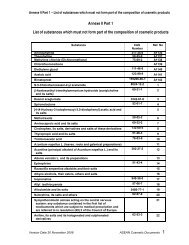Pollution from Personal Actions, Activities, and Behaviors - US ...
Pollution from Personal Actions, Activities, and Behaviors - US ...
Pollution from Personal Actions, Activities, and Behaviors - US ...
Create successful ePaper yourself
Turn your PDF publications into a flip-book with our unique Google optimized e-Paper software.
††Factors Leading to the Precautionary Principle<br />
Science (objective; data oriented) Y<br />
quick <strong>and</strong> versed at delimiting with certainty what is unknown<br />
slow but able to define what is knowable<br />
poor at separating the unknowable <strong>from</strong> the unknown<br />
incapable of removing all uncertainty (absolute current limitations of knowledge)<br />
Science + Uncertainty Y Scientific Certainty<br />
Science + Uncertainty + Policy/Political judgment Y course of further study or action<br />
(subjective, value-oriented, emotional, but rational nonetheless in its approach)<br />
Fusing science with Judgment is a balancing act designed to avoid:<br />
actions based on “type I errors” (false alarms; false positives)<br />
==> improperly taking action based on incorrect or insufficient data<br />
inactions based on “type II errors” (failed alarms; overlooked significance)<br />
==> not taking action when it was indeed warranted<br />
For some comprehensive discussions on the Precautionary Principle, refer to:<br />
http://www.biotech-info.net/uncertainty.html<br />
RISK ASSESSMENT: A final phase of the “risk paradigm” leads to the assessment of risk. In<br />
conclusion, numerous questions can be raised with regard to regulation <strong>and</strong> liability. The salient points<br />
regarding risk assessment pertain to the main, distinct issues regarding human health <strong>and</strong> aquatic health –<br />
as the two differ in many respects (as outlined in the above discussion).<br />
Perhaps the main question with respect to risk assessment, is whether the current approaches to risk<br />
assessment are sufficiently inclusive of chemical exposure. Questions can be raised as to whether the<br />
approaches to environmental risk assessment <strong>and</strong> epidemiological studies sufficiently consider the<br />
“universe” of toxic substances involved in exposure – the corollary being whether the decades-long focus<br />
on conventional “priority pollutants” might give too narrow of a perspective.<br />
In light of the complexities of the overall issue (esp. <strong>from</strong> the perspective of the Risk Cup), any<br />
regulatory decisions are ultimately NOT solely a matter of science – as they must also factor in a broad<br />
spectrum of complex, interacting societal values.<br />
Environmental Health via Public Education<br />
The Government Performance <strong>and</strong> Results Act of 1993 (GPRA) provides the m<strong>and</strong>ate to Federal<br />
agencies to account for program results through the integration of strategic planning, budgeting, <strong>and</strong><br />
performance measurement – with an emphasis on outcomes (e.g., impact) as opposed to outputs (e.g.,<br />
products); a discussion of GPRA as cast for the science community can be found at:<br />
prepared by C.G. Daughton, Ph.D. page 10 of 13<br />
U.S. EPA, ORD/NERL, Las Vegas, NV 18 February 2001





![View Clearinghouse copy of document [PDF]](https://img.yumpu.com/9233544/1/190x245/view-clearinghouse-copy-of-document-pdf.jpg?quality=85)